Order Heterodontiformes:
Bullhead Sharks — 9 species
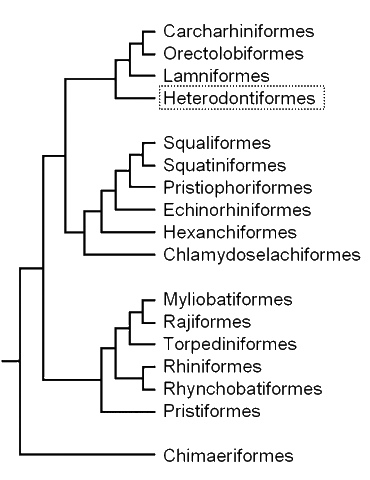
- snout pig-like, deep nasoral groove connecting nostrils to mouth corners
- prominent ridge above each eye; eyes without nictitating fold
- five pairs of gill slits, the last three above the pectoral fin base; spiracles tiny
- a stout spine on the forward margin of both dorsal fins
- presence of an anal fin (which serves to distinguish them from the spiny dogfishes, order Squaliformes)
- in adults, molar-like crushing teeth in rear of the jaws that are very different from the conical grasping teeth in front (hence the group's scientific name, which means "different teeth")
- oviparous; egg case auger-shaped, conical with two broad flanges spiraling from apex to base
- bottom-dwellers in shallow coastal waters (usually less than 300 feet or 100 metres); exclusively marine, inhabiting warm temperate and tropical parts of the western and eastern Pacific and western Indian oceans
- a single genus (Heterodontus) in the family Heterodontidae
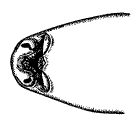
|
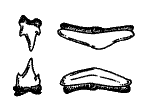
|
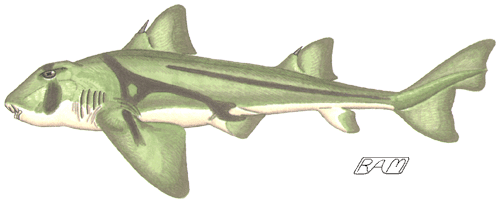
A representative heterodontoid, the Port Jackson Shark (Heterodontus portusjacksoni), showing the characteristic deep nasoral grooves, small mouth with thick labial (lip) cartilages, pronounced brow ridges, stout spine in front of each dorsal fin, and the presence of an anal fin. Like all bullhead sharks, adults of the Port Jackson have teeth that are strongly differentiated in both jaws: peg-like grasping teeth in the front, molar-like crushing teeth in the rear. The body markings shown here are unique to the Port Jackson Shark, consisting of a saddle-like pattern mid-flank and a dark stripe under each eye. These eye stripes (called 'Malor stripes') are believed to reduce glare as the shark swims over highly reflective bottoms, in much the same way that footballers and soldiers reduce glare by applying grease paint under their eyes.
The heterodontoids just don't get the respect they deserve as card-carrying, union-member sharks. It's not their fault — they are victims of their own appearance. Bullhead sharks have a pig-like snout and a small puckered mouth, a surprised expression punctuated by bovine brow-ridges, and a chubby little body sparkling with over-sized scales. Bullheads move with an endearing clumsiness — either clambering over the bottom on large, paddle-like pectoral fins or swimming with an exaggerated wriggle, resembling fat-bellied pollywogs. An embodiment of piscine cuteness, bullheads seem an ideal antidote to the pernicious image with which all sharks have been saddled since JAWS.

|
Dorsal fin skeleton of a Horn Shark (Heterodontus francisci) showing the stout fin spine and reduced fin skeleton — compare this illustration with that of the Spiny Dogfish fin skeleton). Fin spines were common in many ancient sharks, and have independantly evolved in two lineages of modern sharks, the bullheads (order Heterodontiformes) and the dogfishes (order Squaliformes). |
|
Jaws of an adult Port Jackson Shark (Heterodontus portusjacksoni), showing the peg-like anterior teeth and molar-like rear teeth. The rear molars show wear from the hard-shelled prey. |
Heterodontoids are nocturnally active predators; juveniles feed on buried worms, adults on small fishes, crustaceans, and molluscs. Bullhead shark table manners range from unrefined to downright comical. When consuming hard-shelled invertebrate prey, bullheads typically grind up the food and swallow it — shell and all — regurgitating the hard parts later. Off California, the Horn Shark (Heterodontus francisci) has a definite predilection for red sea urchins, which often results in its teeth being stained reddish-brown - like the tongue of a child that has just finished a grape popsicle. Horn sharks apparently also appreciate interactive novelty snacks, as some have been observed to 'pounce' on sea anemones, nipping off a mouthful of tentacles before the hapless invertebrate could retract them.

Horn Shark (Heterodontus francisci)
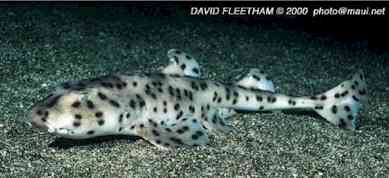 As its name suggests, the Galapagos Horn Shark
(Heterodontus quoyi) is endemic to the Galapagos Islands and other
islands off Peru. Growing to a length of 22 inches (57 centimetres), it is
most active at night and feeds heavily on crabs. This species is often
observed resting on ledges of vertical rock faces at depths of 50 to 100
feet (15 to 30 metres). Despite its defensive dorsal spines, one small
specimen was found in the stomach of a Tiger Shark (Galeocerdo cuvier).
As its name suggests, the Galapagos Horn Shark
(Heterodontus quoyi) is endemic to the Galapagos Islands and other
islands off Peru. Growing to a length of 22 inches (57 centimetres), it is
most active at night and feeds heavily on crabs. This species is often
observed resting on ledges of vertical rock faces at depths of 50 to 100
feet (15 to 30 metres). Despite its defensive dorsal spines, one small
specimen was found in the stomach of a Tiger Shark (Galeocerdo cuvier).
Photo © David Fleetham david@davidfleetham.com; used with the gracious permission of the photographer.
Bullheads are smallish sharks, the various species growing to lengths of 4 to 5.6 feet (1.2 to 1.7 metres). Their modest size renders bullheads vulnerable to predation. The characteristic fin spines of bullheads are an effective anti-predator device, discouraging larger fishes from eating these snack-sized sharks. On several occasions, Pacific Angel Sharks (Squatina californica) off California have been filmed swallowing juvenile Horn Sharks, only to disgorge them with much haste and what looks for all the world like abject disgust. There is even a report from Australia of a Port Jackson Shark (Heterodontus portusjacksoni) stuck in the mouth of a dead wobbegong, which was apparently asphyxiated by its prickly last meal.
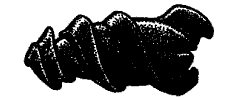
|
|
Auger-shaped eggcase of a Horn Shark (Heterodontus francisci) |
The egg cases of bullhead sharks are among the most wonderfully bizarre in all of Nature. They are auger-shaped: more-or-less conical and surrounded by two broad spiral flanges. This shape enables a mother bullhead to wedge her eggs (usually laid two at a time) into crevices, preventing removal by most would-be predators without benefit of opposable thumbs. The Crested Bullhead, (Heterodontus galeatus) has egg cases with a pair of tendrils, which readily tangle around kelp structures, anchoring them. The Japanese Bullhead (Heterodontus japonicus) apparently uses communal nesting sites — with as many as 15 eggs deposited in the same patch — using them as a kind of heterodontoid day care. Due to their awkward shape, each bullhead egg case requires several hours to rotate out of the mother shark's cloaca. Even in the very serious matter of perpetuating their lineage, heterodontoids are less-than-dignified.
Bullhead eggs hatch after a gestation period of 5 to 12 months, depending upon species and water temperature. Size at birth varies with species, ranging from 5.5 to 9.5 inches (14 to 24 centimetres) in length. Recent studies by Wesley Strong off California indicate that adult horn sharks utilize a home range of up to 10,760 square feet (1,000 square metres); tagging studies in eastern Australia have revealed that the Port Jackson Shark makes annual migrations of up to 525 miles (850 kilometres) along the coast. Bullheads do well in private and public aquaria, the Horn Shark both breeding and holding the record for longevity in captivity at 25 years.
 Like the rest of their bodies, the
pronounced brow-ridges that give the bullhead sharks their vernacular name
are covered with large dermal denticles. Those individuals that
habitually rest with their heads under rock or coral ledges often have
their brow-ridge denticles polished smooth. Others — like this Horn
Shark (Heterodonts francisci) — that rest with their heads al
fresco, have rough, unabraded denticles atop their brow-ridges.
Like the rest of their bodies, the
pronounced brow-ridges that give the bullhead sharks their vernacular name
are covered with large dermal denticles. Those individuals that
habitually rest with their heads under rock or coral ledges often have
their brow-ridge denticles polished smooth. Others — like this Horn
Shark (Heterodonts francisci) — that rest with their heads al
fresco, have rough, unabraded denticles atop their brow-ridges.
Photo © Jeremy Stafford-Deitsch; used with the gracious permission of the photographer, who asks that you support the Shark Trust.
Ecology of the Horn Shark | Ecology of the Port Jackson Shark

